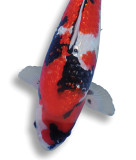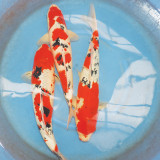
In order to raise healthy Nishikigoi, you must feed koi high-quality food and below are some tips on how to improve koi health, color, and pond water quality. Why is High-Quality Koi Food Important? High-quality koi food is important for your koi because it helps improve health, promote more vibrant colors, and increases water clarity […]
Read MoreKoi of the Doitsu variety have few to no scales. Doitsu goi are old, yet new — they were developed more than 100 years ago, but many new varieties keep coming from Doitsu varieties. Because of their characteristics, they can be crossed with almost any koi variety. Like the diamond-scaled Ginrin, Doitsu has contributed to […]
Read MoreDepending on how you categorize koi, it is said that there are as many as 120 different varieties. And the Ginrin variety definitely contributes to the wide-range attraction of koi. Ginrin is a unique variety because its shine can appear in almost all the varieties. Although Ginrin varieties are all shiny koi, there are distinctive […]
Read MoreKoromo and Goshiki are two separate koi varieties, but at almost all the koi shows, they are categorized as one. At a glance, they may look like completely different varieties. Their roots, however, are the same: Asagi and Kohaku. Because the Goshiki variety has advanced so much (as you can see in photo 1, above […]
Read MoreTancho is not always a winner at koi shows. In fact, some koi shows do not even have a Tancho category. But it is not too much exaggeration to say that Tancho is one of the most popular varieties of koi. To be precise, Tancho is not really a fixed variety like the others. Rather, […]
Read MoreFor many koi lovers, koi appreciation is about admiring the juxtaposition of colors. When it comes to Hikari Muji, however, all of the beauty is conveyed in just one hue. Check out Taro Kodama’s story to learn about the unique characteristics of this monochrome breed … and how to make simple beauty a part of your pond or koi business.
Read MoreThe Japanese word asagi refers to a light indigo color, so it’s easy to guess what this beautiful variety of koi might look like. But it’s more than just color that makes Asagi so impressive. Continuing his exclusive koi masterclass, Taro Kodama illustrates the unique characteristics of this unusually attractive fish.
Read MoreWith their rich lacquer blacks and stunning reds, whites and yellows, the fish of the Utsurimono family are some of the industry’s most revered koi. But their prominence was not always guaranteed. Resident koi expert Taro Kodama explains the unique history and characteristics of these beautiful living treasures.
Read MoreKoi come in a handful of different and exciting varieties, but many breeders only deal with one. What makes Showa so special? Taro Kodama sheds some light on the history and characteristics of this beautiful and well-loved three-colored koi.
Read MoreAlthough they’re a challenging variety of koi to breed (and even harder to make money on), Sanke are definitely not difficult to appreciate. Koi expert Taro Kodama of Kodama Koi Farm shares some of the secrets that make this tri-colored breed so special.
Read More- « Previous
- 1
- 2
- 3
- Next »


